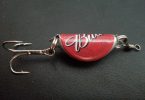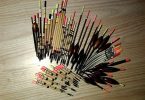So why use a baitcaster? Fixed spool reels can cast just as far, can’t they? They probably can under certain circumstances, but that’s not the whole story.
A baitcaster does have certain advantages. For example, the line on a baitcaster doesn’t go under a bail arm and change direction by 90 degrees before winding onto a spool as a fixed spool reel does. It goes onto the spool in a straight line, putting you in direct contact with the lure or the fish at the other end. You have more winching power available on a baitcaster, due to the direct drive nature of the reel and that can make a big difference when you’re winding down on a big fish or trying to work a deep diving crankbait with an extra large lip
What about accuracy? If you’ve always used a fixed spool reel then you can probably fire a lure more or less where you want it to go and for close in work under the rod tip, a fixed spool reel is just as good. But for middle and far distance fishing, the baitcaster is hard to beat. Get the direction right and as long as you keep sight of the lure, your thumb can control the distance, which leads me to another reason why I like baitcasters. It’s the ability to cast single handed with light/medium rods. Always much easier to control the line release with your thumb on a baitcaster, than it is to control the line release with an extended index finger on a fixed spool reel. More about the importance of the thumb later.
Lastly, I find these reels fun to use and the ability to cast well is sometimes just as satisfying as the ability to catch fish. Something we have in common with flycasters.
You’ve bought a baitcaster, what next? Make sure that you have the right rod.
A baitcasting rod will generally be shorter than a spinning rod, usually with a small trigger grip on the back of the reel fitting for your fingers to wrap around and anchor your hand comfortably to the reel. It will also have smaller rod rings (guides) with the butt rings being notably smaller than that on a spinning rod. Whilst a dedicated baitcasting rod is desirable, you could also use a standard spinning rod. It works after a fashion but I would suggest that you only use it in the interim before buying a rod purpose built for a baitcaster reel.
Need some line to put on your new reel?
Line being retrieved is distributed across the face of the spool by a level wind that in theory should lay line in a criss-cross fashion, thus ensuring that it will not ‘bed in’ to the line underneath. ‘Bedding in’ causes your lure to stop dead in mid flight and often results in a ‘crack off’ and that means broken line and a lost lure. In practice the level wind is only really successful with higher diameter superbraids and mono, so for relatively trouble free casting you should be using at least 30lb braid or 15lb mono. If you must use lighter breaking strain braid then avoid the very low diameter lines like PowerPro and use larger diameter lines like Berkely Fireline to reduce bedding in problems.
Assuming you’ve bought some braid, how do you put the line on the reel?
Braid has no stretch and thus won’t grip the spool like mono, so even a full spool of braid is liable to slip around the spool under pressure if there’s nothing to anchor it. The traditional method of attaching braid is to knot a length of mono onto the spool and run on a tight bed of 20-25 turns. Then knot the braid to the mono and run the braid over the mono until the spool is filled to about ¼” from the rim. The problem with this method is that the bumps from two bulky knots can affect the line lay.
This is my preferred method. Cut a piece of electrician’s tape about 4 inches long. Run the braid onto the spool with no knot, just run it around the spool crossing over itself for about 7/8 turns, just enough to hold it in place. A little fiddly but not difficult. Put the piece of tape over the turns of line, stretching the tape so that it goes on very tight and fixes the braid to the spool. Then continue to run the braid over the tape onto the spool until its ¼” from the rim. Running it through a damp cloth helps to remove any initial stiffness in the braid and you’ll get a little more line tightly on the reel. No knots anywhere and the line goes on smoothly without running over bumps. If you feel that your casting skills are such that you’ll empty a spool on the cast (you wish!) then knot the braid to the spool first. But I’ve never seen the need and I’ve never lost a spool full of line (or fish) as a result.
So I have a reel full of line, can I start casting? Not until I tell you about the dreaded ‘birds nest’.
The birdsnest or ‘backlash’ occurs when the spool spins faster than the line is going through the rod tip and the line backs up and overruns around the spool in a loose uncontrolled bunch. You now have something that closely resembles Brian May’s hair and it could be severe enough to stop you fishing for the day. It happens when either the line has bedded in for a split second but the spool then keeps on spinning whilst the lure has slowed, or the lure is too light to pull line off the reel. Casting into the wind can sometimes cause problems too.
Trouble free baitcasting is about equating the speed that the lure is moving with the speed that the spool is spinning and the key is having what’s called an ‘educated thumb’. With your thumb hovering just close enough to the spinning spool to feel the line coming off, you can increase or decrease pressure on the spool just enough to stop a birdsnest happening the moment you feel the coils of line begin to lift off the spool. If you think the cast is going too far and fast or is heading for the trees you can stop it immediately with your thumb. Always watch the lure in flight and t
he minute it hits the water stop the spool with your thumb. Eventually you’ll develop a sixth sense about when to slow down or stop the spool.
There are also a few basic controls that you need to be familiar with.
The star wheel under the handle sets the drag. Clockwise —increases the drag, anti-clockwise reduces it. Set the clutch before fishing by whatever method you use for your fixed spool reels. I like to set mine with a spring balance at around 1/4 breaking strain if using braid. If I need to tighten up on a bigger fish I’ll do so.
To put the reel into free spool mode, depress the spool release bar or button that on most popular reels should be just at the back of the reel frame and close to your thumb. To put it back into gear just wind the handle forward.
 Braking power…other than the thumb, consists of either of two types, centrifugal or magnetic brakes. The centrifugal brakes will either be on the spool under the front or rear side plate depending upon make and model and you may need to slide out the spool to access them. Round baitcasters like the ABU 5500/6500 provide access by three knurled nuts on the sideplate under the handle, whilst the Shimano Calcutta (and clones) has two. These should be kept finger tight so that you can easily change brake settings on the bank. Low profile baitcasters like the Shimano Curado/Calais family of reels provide access to the brakes via a detachable rear sideplate.
Braking power…other than the thumb, consists of either of two types, centrifugal or magnetic brakes. The centrifugal brakes will either be on the spool under the front or rear side plate depending upon make and model and you may need to slide out the spool to access them. Round baitcasters like the ABU 5500/6500 provide access by three knurled nuts on the sideplate under the handle, whilst the Shimano Calcutta (and clones) has two. These should be kept finger tight so that you can easily change brake settings on the bank. Low profile baitcasters like the Shimano Curado/Calais family of reels provide access to the brakes via a detachable rear sideplate.
Centrifugal braking systems consist of two to six plastic brake blocks on pins running outwards from the centre on the side of the spool. If you gently depress the block down the pin and towards the centre, you’ll possibly hear a faint click as they are locked on the pin in the ‘off’ position and are no longer in play. Push them up and they lock into the ‘on’ position and are in play. Push them too hard and they’ll pop off the end of the pin but they go back just as easily. How many brakes you choose to use depends on your casting ability and the weight of your lure.
Magnetic brakes are very simple and are adjusted by a dial on the outside of the rear sideplate. But whatever the system, the same rules apply …….heavy lures require less braking…….light lures more braking. But start with all brakes ‘on’ and when you become proficient then you might want to try turning off all of the brakes and controlling the spool with your newly educated thumb.
That leaves just the cast control cap. Most reels have one (not all) and it’s a small metal knurled cap resembling a thimble located at the centre of the front sideplate under the handle. Its function is to control the amount of ‘float’ that the spool spindle has between the two spool bearings. Turn it anti-clockwise and the spool floats free and if you grasp the spool and push left or right you’ll feel sideways movement within the frame. Turn the cap clockwise and you’ll eventually feel the spool lock up. Experienced casters like to have just a trace of float in the spool.
Almost forgot the flippin’ switch. It’s a button that is rare on UK reels but not so if your reel was made specifically for the US bass fishing market. Push the button and the reel is in free spool. Release it and its back in gear. It’s a quick one-handed way to let line off the spool. Useful when fishing holes in weed beds and you want to let out a little more line without losing contact with your lure.
Casting starts here. Ideally the best way to learn is to find someone who can use a baitcaster well and get them to show you how its done.
Failing that try this. Make sure that all brakes are ‘on’ (the usual factory setting) then with a lure clipped onto your trace, hold your rod outwards at about 30 degrees up from horizontal with the reel facing up. Be sure to use a reasonably heavy lure at least half the maximum weight that your rod is supposed to handle, it’ll make your initial casts easier. Now wind in line until the lure is 4 to 6 inches from the rod tip. Next turn the cast control cap clockwise until the spool is locked. Now depress the thumb bar (or button). The spool is now in "free spool" mode but the lure won’t move because you’ve tightened the cast control knob.
Now, using your spare thumb and forefinger, turn the cast control cap "anti-clockwise" very slowly until the lure starts to drop from it’s own weight. It should drop slowly to the ground and stop without you touching the spool. Its now set and should not require resetting unless you switch to a much heavier or lighter lure or you find yourself fishing into a headwind
Now try an overhead cast. Start with the lure hanging about 18 inches from the rod tip and the reel in free spool and trapped by your thumb. Being right handed you would naturally hold the rod with your right hand and wind with your left hand, left handers doing the opposite. Under those circumstances the reel handles should be pointing downwards not sideways, bringing your wrist around into a natural relaxed position helping you to guide the lure in the right direction. With both hands on the rod, try a simple overhead lob. Bring the rod back over your shoulder about 45 degrees to the horizontal, then as the line straightens (you’ll feel it pull on the rod tip) bring it smartly but smoothly forward, releasing your thumb from the spool when the rod reaches the forward position about 40-50 degrees from horizontal. Don’t force the cast, make it unhurried and just concentrate on releasing the line cleanly, even if the lure only goes a few yards. Distance comes with practice. Remember to keep your thumb hovering just over the spool, just close enough to feel the line spinning off the spool and then watch the lure in flight. Stop the spool when the lure hits the water hopefully on target. Piece of cake!
Copyright 2006
Gerry Castles








